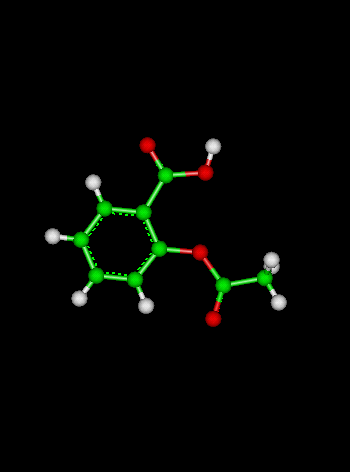
Course Chapters
Section Tests
Online Calculators Linear Least Squares Regression Newton's Method Equation Solver
Related Information Links
|
Atomic StructureAn atom is the smallest building block of matter. Atoms are made of neutrons, protons and electrons. The nucleus of an atom is extremely small in comparison to the atom. If an atom was the size of the Houston Astrodome, then its nucleus would be the size of a pea.
Introduction to the Periodic TableScientists use the Periodic Table in order to find out important information about various elements. Created by Dmitri Mendeleev (1834-1907), the periodic table orders all known elements in accordance to their similarities. When Mendeleev began grouping elements, he noticed the Law of Chemical Periodicity. This law states, "the properties of the elements are periodic functions of atomic number." The periodic table is a chart that categorizes elements by "groups" and "periods." All elements are ordered by their atomic number. The atomic number is the number of protons per atom. In a neutral atom, the number of electrons equals the number of protons. The periodic table represents neutral atoms. The atomic number is typically located above the element symbol. Beneath the element symbol is the atomic mass. Atomic mass is measured in Atomic Mass Units where 1 amu = (1/12) mass of carbon measured in grams. The atomic mass number is equal to the number of protons plus neutrons, which provides the average weight of all isotopes of any given element. This number is typically found beneath the element symbol. Atoms with the same atomic number, but different mass numbers are called isotopes. Below is a diagram of a typical cells on the periodic table.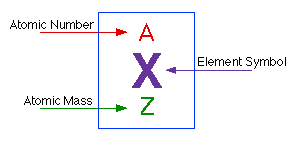
There are two main classifications in the periodic table, "groups" and "periods." Groups are the vertical columns that include elements with similar chemical and physical properties. Periods are the horizontal rows. Going from left to right on the periodic table, you will find metals, then metalloids, and finally nonmetals. The 4th, 5th, and 6th periods are called the transition metals. These elements are all metals and can be found pure in nature. They are known for their beauty and durability. The transition metals include two periods known as the lanthanides and the actinides, which are located at the very bottom of the periodic table. The chart below gives a brief description of each group in the periodic table.
Charges in the AtomThe charges in the atom are crucial in understanding how the atom works. An electron has a negative charge, a proton has a positive charge and a neutron has no charge. Electrons and protons have the same magnitude of charge. Like charges repel, so protons repel one another as do electrons. Opposite charges attract which causes the electrons to be attracted to the protons. As the electrons and protons grow farther apart, the forces they exert on each other decrease.
Atomic Models and the Quantum NumbersThere are different models of the structure of the atom. One of the first models was created by Niels Bohr, a Danish physicist. He proposed a model in which electrons circle the nucleus in "orbits" around the nucleus, much in the same way as planets orbit the sun. Each orbit represents an energy level which can be determined using equations generated by Planck and others discussed in more detail below. The Bohr model was later proven to be incorrect, but provides a useful model for building an explanation.The "accepted" model is the quantum model. In the quantum model, we state that the electron cannot be found precisely, but we can predict the probability, or likelihood, of an electron being at some location in the atom. You should be familiar with quantum numbers, a series of three numbers used to describe the location of some object (like an electron) in three-dimensional space:
Chemists care about where electrons are in an atom or a molecule. In the early models, we believed that electrons move like billiard balls, and followed the rules of classical physics. The graphic below attempts to show that earlier models thought that we could identify the exact path, position, velocity, etc. of an electron or electrons in an atom:
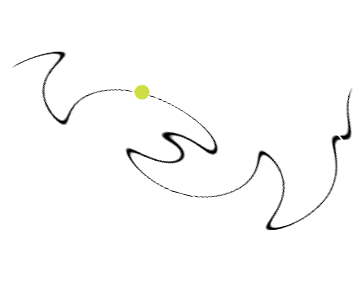 A more accurate picture is that the electron(s) reside in a "cloud" that surrounds the nucleus of the atom. This concept is shown in the graphic below:
 Chemists are interested in predicting the probability that the electron will be at some particular part of this cloud. The cloud is better known as an orbital, and comes in several different types, or shapes. Atomic orbitals are known as s, p, d, and f orbitals. Each type of atomic orbital has certain characteristics, such as shape. For example, as the graphic below shows, an s orbital is spherical in shape:
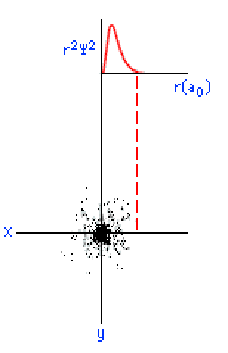 On this graph, the horizontal (x) axis represents the distance from the nucleus in units of a0, or atomic units. The value of a0 is 0.0529 nanometers (nm). The vertical (y) axis represents the probability density. What you should notice is that as the electron moves farther away from the nucleus, the probability of its being found at that distance decreases. In other words, the electron prefers to hang around close to the nucleus. The three graphics below show some other orbitals. The first graph (top left) is of a "2s" orbital. Each "s" orbital can hold two electrons in its cloud. Notice how there is a relatively high probability of an electron being near the nucleus, then some space where the probability is close to zero, then the probability increases substantially at some distance from the nucleus. The graphic at the top right shows a "2p" atomic orbital. Orbitals that are "p" orbitals can hold up to six (6) electrons in their cloud. Notice its "dumbbell" or "figure of eight" shape. At the bottom left is a "3s" orbital. Again, notice its spherical shape. Finally, at the bottom right, is a "3p" orbital.
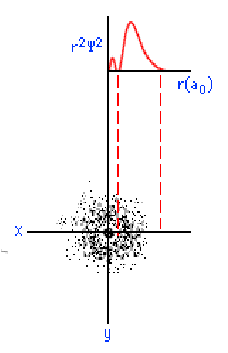 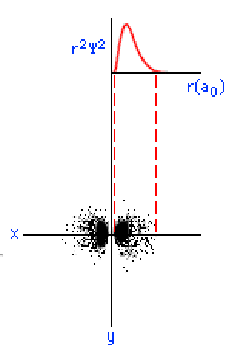 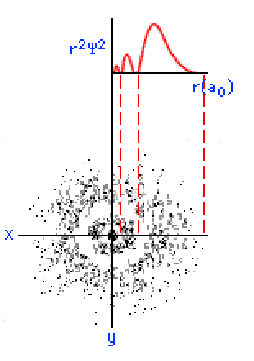 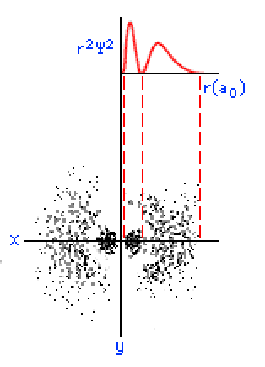
Determining Electron ConfigurationOne of the skills you will need to learn to succeed in freshman chemistry is being able to determine the electron configuration of an atom. An electron configuration is basically an account of how many electrons there are, and in what orbitals they reside under "normal" conditions. For example, the element hydrogen (H) has one electron. We know this because its atomic number is one (1), and the atomic number tells you the number of electrons. Where does this electron go? The one electron of hydrogen goes into the lowest energy state it possibly can, which means it will start at "level" one and goes into "s" orbitals first. We say that hydrogen has a "[1s1]" electron configuration. Looking at the next element on the Periodic Table --helium, or He -- we see it has an atomic number of two, so two electrons. Since " s" orbitals can hold up to two electrons, helium has an electron configuration of "[1s2]".
What about larger atoms? Let's look at carbon, with an atomic number of 6. Where do its 6 electrons go?
We can therefore say that carbon has the electron configuration of "[1s22s22p2]". The table below shows the subshells, the number of orbitals, and the maximum number of electrons allowed:
Sometimes you will see the notation: "[Ne]3s23p6", which means to include everything that is in neon (Ne, 10) plus the stuff in the "3"-level orbitals.
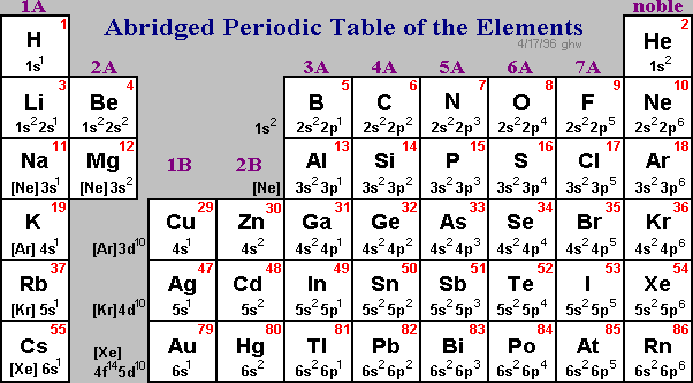
Try It Out
[Basic Index]
[Chemical Nomenclature]
[Atomic Structure]
[Periodic Table] |
 Shodor
Shodorin cooperation with the Department of Chemistry,
The University of North Carolina at Chapel Hill
Copyright © 1996-2008 Shodor
Last Update: Sunday, 06-Oct-2002 13:08:39 EDT
Please direct questions and comments about this page to
WebMaster@shodor.org